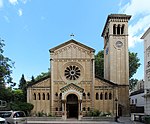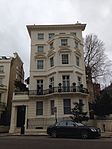Kingston House estate, London

The Kingston House estate and Ennismore Gardens in Knightsbridge is a green, dual-character area within the western limits of the City of Westminster in London. The first-named is immediately south of Hyde Park, London taking up the park's semi-panorama row of 8 to 13 Princes Gate (demolished) and otherwise, as to more of its wings, set around the east of Princes Gate Garden including a terrace of houses №s 1 to 7 Bolney Gate. The second-named is a garden square of 59 tall creamy-white terraced houses and the approach road to Prince of Wales Gate, Hyde Park as well as the identical-size public, square green of the church that is since 1956 the Russian Orthodox Cathedral of the Dormition of the Mother of God and All Saints facing which green are its anomalous outlier row for a London garden square, №s 61 to 66. The relatively small, broad-fronted house set against the Consulate-used pairing at №s 61 to 62 is № 60 and as with the other 65 numbers of Ennismore Gardens is a listed building. Kingston House estate has some Art Deco features but has no statutorily listed buildings. It has four 1930s to 1950s ranges of flats in 1930s style, arranged in three parts.
Excerpt from the Wikipedia article Kingston House estate, London (License: CC BY-SA 3.0, Authors, Images).Kingston House estate, London
Knightsbridge, London Knightsbridge
Geographical coordinates (GPS) Address Nearby Places Show on map
Geographical coordinates (GPS)
| Latitude | Longitude |
|---|---|
| N 51.5014 ° | E -0.1713 ° |
Address
Kingston House North
Knightsbridge
SW7 1SF London, Knightsbridge
England, United Kingdom
Open on Google Maps










